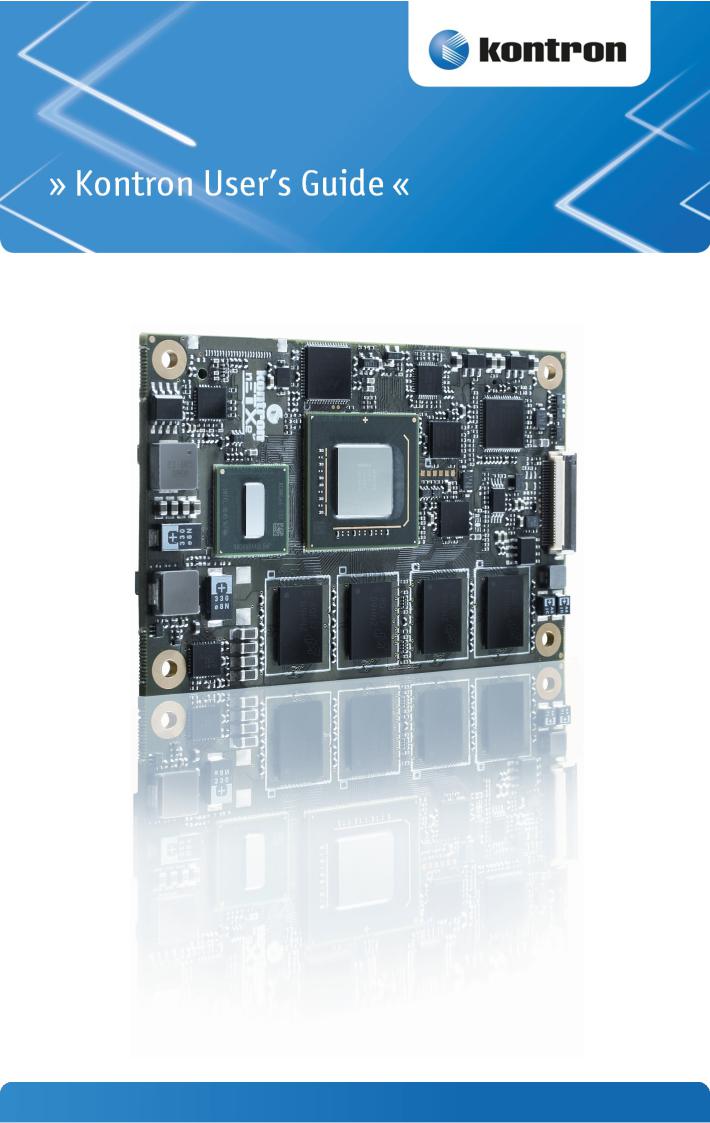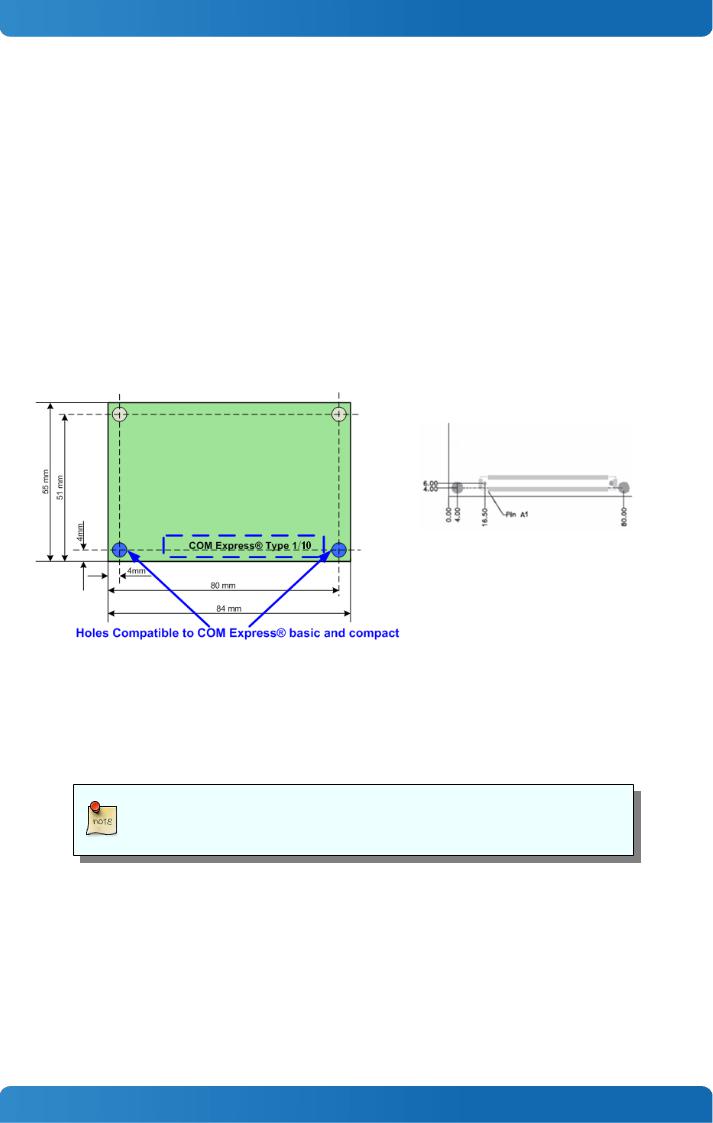Kontron COMe-mSP1 User Manual

COMe-mSP1
Document Revision 160
www.kontron.com

» Table of Contents « |
|
|
1 |
User Information.................................................................................. |
6 |
1.1 |
About This Document.................................................................................................................... |
6 |
1.2 |
Copyright Notice.......................................................................................................................... |
6 |
1.3 |
Trademarks................................................................................................................................. |
6 |
1.4 |
Standards................................................................................................................................... |
6 |
1.5 |
Warranty.................................................................................................................................... |
7 |
1.6 |
Technical Support......................................................................................................................... |
7 |
2 |
Introduction........................................................................................ |
8 |
2.1 |
Product Description...................................................................................................................... |
8 |
2.2 |
Naming clarification..................................................................................................................... |
8 |
2.3 |
Understanding COM Express® Functionality....................................................................................... |
9 |
2.4 |
COM Express® Documentation....................................................................................................... |
10 |
2.5 |
COM Express® Benefits................................................................................................................ |
10 |
3 |
Product Specification........................................................................... |
11 |
3.1 |
Modules & Accessories................................................................................................................. |
11 |
3.2 |
Functional Specification............................................................................................................... |
13 |
3.3 |
Block Diagram............................................................................................................................ |
17 |
3.4 |
Electrical Specification................................................................................................................ |
18 |
3.4.1 |
Supply Voltage........................................................................................................................... |
18 |
3.4.2 |
Power Supply Rise Time................................................................................................................ |
18 |
3.4.3 |
Supply Voltage Ripple.................................................................................................................. |
18 |
3.4.4 |
Power Consumption..................................................................................................................... |
18 |
3.4.5 |
ATX Mode.................................................................................................................................. |
19 |
3.4.6 |
Single Supply Mode..................................................................................................................... |
19 |
3.5 |
Power Control............................................................................................................................ |
20 |
3.6 |
Environmental Specification......................................................................................................... |
21 |
3.6.1 |
Temperature Specification............................................................................................................ |
21 |
3.6.2 |
Humidity................................................................................................................................... |
21 |
3.7 |
Standards and Certifications......................................................................................................... |
22 |
3.8 |
MTBF........................................................................................................................................ |
24 |
3.9 |
Mechanical Specification.............................................................................................................. |
25 |
3.9.1 |
Module Dimension...................................................................................................................... |
25 |
3.9.2 |
Height on Top............................................................................................................................ |
25 |
3.9.3 |
Height on Bottom....................................................................................................................... |
25 |
3.9.4 |
Mechanical Drawing.................................................................................................................... |
25 |
3.10 |
Thermal Management.................................................................................................................. |
26 |
3.11 |
Heatspreader............................................................................................................................. |
26 |
4 |
Features and Interfaces....................................................................... |
27 |
4.1 |
Onboard SSD.............................................................................................................................. |
27 |
4.2 |
LPC.......................................................................................................................................... |
28 |
www.kontron.com

COMe-mSP1 /
4.3 |
LPC boot................................................................................................................................... |
29 |
4.4 |
M.A.R.S.................................................................................................................................... |
30 |
4.5 |
Fast I2C & SMBus........................................................................................................................ |
31 |
4.6 |
JIDA16 and JIDA32..................................................................................................................... |
32 |
4.7 |
K-Station 1................................................................................................................................ |
33 |
4.8 |
K-Station & API Resources............................................................................................................ |
34 |
4.8.1 |
I2C.......................................................................................................................................... |
34 |
4.8.2 |
Storage.................................................................................................................................... |
34 |
4.8.3 |
GPIO........................................................................................................................................ |
34 |
4.8.4 |
Hardware Monitor....................................................................................................................... |
34 |
4.9 |
GPIO - General Purpose Input and Output......................................................................................... |
35 |
4.10 |
Watchdog Timer.......................................................................................................................... |
36 |
4.11 |
Flash Backup Feature................................................................................................................... |
37 |
4.12 |
Speedstep Technology................................................................................................................. |
39 |
4.13 |
C-States.................................................................................................................................... |
40 |
4.14 |
Hyper Threading......................................................................................................................... |
41 |
4.15 |
ACPI Suspend Modes and Resume Events.......................................................................................... |
42 |
4.16 |
USB......................................................................................................................................... |
43 |
4.17 |
SDIO........................................................................................................................................ |
44 |
4.18 |
Graphics Interface...................................................................................................................... |
45 |
4.19 |
LPC Bus..................................................................................................................................... |
47 |
5 |
System Resources............................................................................... |
49 |
5.1 |
Interrupt Request (IRQ) Lines........................................................................................................ |
49 |
5.1.1 |
In 8259 PIC Mode........................................................................................................................ |
49 |
5.1.2 |
In APIC mode............................................................................................................................. |
50 |
5.2 |
Memory Area.............................................................................................................................. |
51 |
5.3 |
I/O Address Map......................................................................................................................... |
51 |
5.4 |
Peripheral Component Interconnect (PCI) Devices............................................................................. |
52 |
5.5 |
Internal I2C Bus......................................................................................................................... |
52 |
5.6 |
JILI I2C Bus............................................................................................................................... |
52 |
5.7 |
SDVO I2C Bus............................................................................................................................. |
52 |
5.8 |
System Management (SM) Bus....................................................................................................... |
52 |
5.9 |
Pinout List................................................................................................................................ |
53 |
5.9.1 |
General Signal Description............................................................................................................ |
53 |
5.9.2 |
Connector X1A Row A................................................................................................................... |
54 |
5.9.3 |
Connector X1A Row B................................................................................................................... |
56 |
5.9.4 |
SDVO Connector J1801 (optional)................................................................................................... |
58 |
5.9.5 |
XDP Connector J1400 (optional).................................................................................................... |
59 |
6 |
BIOS Operation................................................................................... |
60 |
6.1 |
Determining the BIOS Version....................................................................................................... |
60 |
6.2 |
BIOS Update.............................................................................................................................. |
60 |
6.3 |
Setup Guide............................................................................................................................... |
61 |
6.3.1 |
Start AMI® BIOS Setup Utility........................................................................................................ |
61 |
6.4 |
BIOS Setup................................................................................................................................ |
63 |
6.4.1 |
Main Menu................................................................................................................................ |
63 |
6.4.2 |
Module Info............................................................................................................................... |
67 |
4

COMe-mSP1 /
6.4.3 |
Advanced Menu.......................................................................................................................... |
71 |
6.4.4 |
Advanced PCI/PnP Settings........................................................................................................... |
91 |
6.4.5 |
Boot........................................................................................................................................ |
91 |
6.4.6 |
Security.................................................................................................................................... |
94 |
6.4.7 |
Advanced Chipset Settings............................................................................................................ |
94 |
6.4.8 |
Exit Menu.................................................................................................................................. |
99 |
5

COMe-mSP1 / User Information
1User Information
1.1About This Document
This document provides information about products from Kontron Europe GmbH and/or its subsidiaries. No warranty of suitability, purpose, or fitness is implied. While every attempt has been made to ensure that the information in this document is accurate, the information contained within is supplied “as-is” and is subject to change without notice.
For the circuits, descriptions and tables indicated, Kontron assumes no responsibility as far as patents or other rights of third parties are concerned.
1.2Copyright Notice
Copyright © 2003-2012 Kontron Europe GmbH
All rights reserved. No part of this document may be reproduced, transmitted, transcribed, stored in a retrieval system, or translated into any language or computer language, in any form or by any means (electronic, mechanical, photocopying, recording, or otherwise), without the express written permission of Kontron Europe GmbH.
DIMM-PC®, PISA®, ETX®, ETXexpress®, microETXexpress®, X-board®, DIMM-IO® and DIMM-BUS® are trademarks or registered trademarks of Kontron Europe GmbH. Kontron is trademark or registered trademark of Kontron AG.
1.3Trademarks
The following lists the trademarks of components used in this board.
»IBM, XT, AT, PS/2 and Personal System/2 are trademarks of International Business Machines Corp.
»Microsoft is a registered trademark of Microsoft Corp.
»Intel is a registered trademark of Intel Corp.
»All other products and trademarks mentioned in this manual are trademarks of their respective owners.
1.4Standards
Kontron Europe GmbH is certified to ISO 9000 standards.
6

COMe-mSP1 / User Information
1.5Warranty
This Kontron Europe GmbH product is warranted against defects in material and workmanship for the warranty period from the date of shipment. During the warranty period, Kontron Europe GmbH will at its discretion decide to repair or replace defective products.
Within the warranty period, the repair of products is free of charge as long as warranty conditions are observed.
The warranty does not apply to defects resulting from improper or inadequate maintenance or handling by the buyer, unauthorized modification or misuse, operation outside of the product’s environmental specifications or improper installation or maintenance.
Kontron Europe GmbH will not be responsible for any defects or damages to other products not supplied by Kontron Europe GmbH that are caused by a faulty Kontron Europe GmbH product.
1.6Technical Support
Technicians and engineers from Kontron Europe GmbH and/or its subsidiaries are available for technical support. We are committed to making our product easy to use and will help you use our products in your systems.
Please consult our Web site at http://www.kontron.com/support for the latest product documentation, utilities, drivers and support contacts. Consult our customer section http://emdcustomersection.kontron.com for the latest BIOS downloads, Product Change Notifications, Board Support Packages, DemoImages, 3D drawings and additional tools and software. In any case you can always contact your board supplier for technical support.
7

COMe-mSP1 / Introduction
2Introduction
2.1Product Description
This credit card sized COM Express® mini module is compatible to COM Express® pin-out Type 1. On 55 mm x 84 mm footprint COMe-mSP1 is a perfect fit for the next generation of low power, ultra-mobile applications that require energy saving x86 processor performance, high-end graphics, PCI Express and Serial ATA combined with longer battery life. These include handheld devices for medical or multi-media applications, small mobile data systems and a host of new applications that have not previously been possible due to size or power consumption limitations.
The Kontron COM Express® mini COM, COMe-mSP1, is based on the highly-efficient Intel® Atom™ Z5xx processor series and Intel® System Controller Hub single chip that combines the memory controller, graphic engine and I/O in a single, space saving chipset design. With only one tenth of the Thermal Design Power and one seventh the size of ULV processors at an identical performance, the COMe-mSP1 COM offers an unprecedented power consumption / performance ratio for x86-based ultra-mobile designs.
The COMe-mSP1 with Flash and memory on-board support 1 PCI Express x1 (opt. 2 x1 if no onboard LAN), Serial ATA, High Definition Audio, LVDS and optional SDVO. 10/100/1000 Gigabit Ethernet is designed in onboard for high connectivity and 8x USB provides fast and sufficient interfaces for external peripherals.
All above mentioned requirements are supported by COM Express® mini - small power - low size - high performance.
2.2Naming clarification
COM Express® defines a Computer-On-Module, or COM, with all components necessary for a bootable host computer, packaged as a super component.
»COMe-bXX# modules are Kontron's COM Express® modules in basic form factor (125mm x 95mm), formerly known as ETXexpress®
»COMe-cXX# modules are Kontron's COM Express® modules in compact form factor (95mm x 95mm), formerly known as microETXexpress®
»COMe-mXX# modules are Kontron's COM Express® modules in mini form factor (55mm x 84mm), formerly known as nanoETXexpress
The product names for Kontron COM Express® Computer-on-Modules consist of a short form of the industry standard (COMe-), the form factor (b=basic, c=compact, m=mini), the capital letters for the CPU and Chipset Codenames (XX) and the pin-out type (#) followed by the CPU Name.
8

COMe-mSP1 / Introduction
2.3Understanding COM Express® Functionality
All Kontron COM Express® basic and compact modules contain two 220pin connectors; each of it has two rows called Row A & B on primary connector and Row C & D on secondary connector. COM Express® Computer-on-modules feature the following maximum amount of interfaces according to the PICMG module Pin-out type:
Feature |
Pin-Out Type 1 |
Pin-Out Type 10 |
Pin-Out Type 2 |
Pin-Out Type 6 |
HD Audio |
1x |
1x |
1x |
1x |
Gbit Ethernet |
1x |
1x |
1x |
1x |
Serial ATA |
4x |
4x |
4x |
4x |
Parallel ATA |
- |
- |
1x |
- |
PCI |
- |
- |
1x |
- |
PCI Express x1 |
6x |
6x |
6x |
8x |
PCI Express x16 (PEG) |
- |
- |
1x |
1x |
USB Client |
1x |
1x |
- |
- |
USB 2.0 |
8x |
8x |
8x |
8x |
USB 3.0 |
- |
2x |
- |
4x |
VGA |
1x |
- |
1x |
1x |
LVDS |
Dual Channel |
Single Channel |
Dual Channel |
Dual Channel |
DP++ (SDVO/DP/HDMI/DVI) |
1x optional |
1x |
3x shared with PEG |
3x |
LPC |
1x |
1x |
1x |
1x |
External SMB |
1x |
1x |
1x |
1x |
External I2C |
1x |
1x |
1x |
1x |
GPIO |
8x |
8x |
8x |
8x |
SDIO |
1x optional |
1x optional |
- |
- |
UART (2-wire COM) |
- |
2x |
- |
2x |
FAN PWM out |
- |
1x |
- |
1x |
|
|
|
|
|
9

COMe-mSP1 / Introduction
2.4COM Express® Documentation
This product manual serves as one of three principal references for a COM Express® design. It documents the specifications and features of COMe-mSP1. Additional references are are available from your Kontron Support or from PICMG®:
»The COM Express® Specification defines the COM Express® module form factor, pin-out, and signals. This document is available from the PIGMG website by filling out the order form.
»The COM Express® Design Guide by PICMG serves as a general guide for baseboard design, with a focus on maximum flexibility to accommodate a wide range of COM Express® modules.
Some of the information contained within this product manual applies only to certain product revisions (CE: xxx). If certain information applies to specific product revisions (CE: xxx) it will be stated. Please check the product revision of your module to see if this information is applicable.
2.5COM Express® Benefits
COM Express® modules are very compact, highly integrated computers. All Kontron COM Express® modules feature a standardized form factor and a standardized connector layout that carry a specified set of signals. Each COM is based on the COM Express® specification. This standardization allows designers to create a single-system baseboard that can accept present and future COM Express® modules.
The baseboard designer can optimize exactly how each of these functions implements physically. Designers can place connectors precisely where needed for the application on a baseboard designed to optimally fit a system’s packaging.
A single baseboard design can use a range of COM Express® modules with different size and pin-out. This flexibility can differentiate products at various price/performance points, or to design future proof systems that have a built-in upgrade path. The modularity of a COM Express® solution also ensures against obsolescence as computer technology evolves. A properly designed COM Express® baseboard can work with several successive generations of COM Express® modules.
A COM Express® baseboard design has many advantages of a custom, computer-board design but delivers better obsolescence protection, greatly reduced engineering effort, and faster time to market.
10

COMe-mSP1 / Product Specification
3Product Specification
3.1Modules & Accessories
The COM Express® mini sized Computer-on-Module COMe-mSP1 (NOW1) follows pin-out Type 1 and is compatible to PICMG specification COM.0 Rev 1.0. The COMe-mSP1, based on Intel's eMenlow platform, is available in different variants to cover the demand of different performance, price and power:
Commercial grade modules (0°C to 60°C operating)
Product Number |
Product Name |
Processor |
SCH and Features |
34001-2040-16-1 |
COMe-mSP1 Z530 2GB/4GB |
Intel® Atom™ Z530 |
US15W, 1xPCIe, 2GB DDR2, 4GB SSD |
34001-1040-16-1 |
COMe-mSP1 Z530 1GB/4GB |
Intel® Atom™ Z530 |
US15W, 1xPCIe, 1GB DDR2, 4GB SSD |
34001-5120-16-1 |
COMe-mSP1 Z530 512MB/2GB |
Intel® Atom™ Z530 |
US15W, 1xPCIe, 512MB DDR2, 2GB SSD |
34001-1020-11-1 |
COMe-mSP1 Z510 1GB/2GB |
Intel® Atom™ Z510 |
US15W, 1xPCIe, 1GB DDR2, 2GB SSD |
34001-5151-11-1 |
COMe-mSP1 Z530 512/512MB |
Intel® Atom™ Z510 |
US15W, 1xPCIe, 512MB DDR2, 512MB SSD |
|
|
|
|
Extended temperature modules (E1, -25°C to 75°C operating)
Product Number |
Product Name |
|
Processor |
SCH and Features |
34001-1040-16-1EXT |
COMe-mSP1 Z530 |
1GB/4GB E1 |
Intel® Atom™ Z530 |
US15W, 1xPCIe, LAN, 1GB DDR2, 4GB SSD |
34001-5120-16-1EXT |
COMe-mSP1 Z530 |
512/2GB E1 |
Intel® Atom™ Z530 |
US15W, 1xPCIe, LAN, 512MB DDR2, 2GB SSD |
34001-5151-11-1EXT |
COMe-mSP1 Z510 512/512M E1 |
Intel® Atom™ Z510 |
US15W, 1xPCIe, LAN, 512MB DDR2, 512MB SSD |
|
|
|
|
|
|
Possible memory and onboard Flash configurations 34001-MMFF-xx-x:
»MM = 51: 512MB DDR2 Memory (4 x 1Gb chips on bottom)
»MM = 10: 1024MB DDR2 Memory (8 x 1Gb chips)
»MM = 20: 2048MB DDR2 Memory (8 x 2Gb chips)
»FF = 00: without PATA SSD
»FF = 51: 512MB onboard PATA SSD
»FF = 10: 1GB onboard PATA SSD
»FF = 20: 2GB onboard PATA SSD
»FF = 40: 4GB onboard PATA SSD
Please contact your local sales for customized Memory and Flash variants or modules with 2xPCIe (no-LAN version)
11

COMe-mSP1 / Product Specification
Accessories
Product Number |
Carrier Boards |
34101-0000-00-1 |
COM Express® Eval Carrier Type 10 |
34100-0000-00-0 |
COM Express® Reference Carrier HMI Type 1 |
Product Number |
Cooling & Mounting |
34001-0000-99-0 |
HSP COMe-mSP1 thread |
34001-0000-99-1 |
HSP COMe-mSP1 through |
34001-0000-99-2 |
HSP COMe-mSP1 slim thread |
34001-0000-99-0CO1 |
HSK COMe-mSP1 slim passive thread |
34099-0000-99-0 |
COMe mini Active Uni Cooler (for CPUs up to 10W) |
34099-0000-99-1 |
COMe mini Passive Uni Cooler (for CPUs up to 5W) |
34099-0000-99-2 |
COMe mini Passive Uni Cooler Slim (for CPUs up to 3-5W) |
34017-0000-00-0 |
COMe mMount KIT 5/8mm 1set |
Product Number |
Adapter & Cables |
9-5000-0352 |
ADA-LVDS-DVI 18bit (LVDS to DVI converter) |
9-5000-0353 |
ADA-LVDS-DVI 24bit (LVDS to DVI converter) |
34120-0000-00-2 |
ADA-COMe-T10-T2 |
12

COMe-mSP1 / Product Specification
3.2Functional Specification
Processor
The Intel® ATOM™ (Silverthorne) CPU family supports:
»Intel® Hyper-Threading Technology
»Intel® Virtualization Technology (VT-x)
»Idle States
»Enhanced Intel SpeedStep® Technology
»Intel® Demand Based Switching
»Thermal Monitoring Technologies
»Execute Disable Bit
CPU specifications
Processor |
Cores / Threads |
CPU Clock |
L2 Cache |
Bus Speed |
VT-x |
HTT |
EIST |
Max TDP |
Intel® Atom™ Z510 |
1 / 1 |
1100MHz |
512KB |
400MHz |
No |
No |
Yes |
2.0W |
Intel® Atom™ Z530 |
1 / 2 |
1600MHz |
512KB |
533MHz |
YES |
YES |
Yes |
2.2W |
|
|
|
|
|
|
|
|
|
Memory
Sockets |
memory down |
Memory Type |
DDR2-533 |
Maximum Size |
2GB |
Technology |
Single Channel (64bit) |
|
|
The total amount of memory available on the module is used for main memory and graphics memory. The Unified Memory Architecture (UMA) manages how the system shares memory between the graphics controller and the processor. The maximum supported memory configuration is 8 x 2Gbit (2GB). Usually modules are equipped with 8 x 1Gbit (1GB) or 4 x 1Gbit (512MB mounted on bottom side of the PCB).
8 memory chips are only supported on hardware revision CE 4.x.x or newer. Former hardware revisions supports up to 4x2Gbit (1GB) system memory.
13

COMe-mSP1 / Product Specification
Graphics Core
The integrated Intel® GMA 500 based on PowerVR SGX535 core supports:
Graphics Core Render Clock |
200MHz, , |
Execution Units / Pixel Pipelines |
4 |
Max Graphics Memory |
352MB |
GFX Memory Bandwidth (GB/s) |
4.2 |
GFX Memory Technology |
DVMT |
API (DirectX/OpenGL) |
9.0c / 2.0 |
Shader Model |
3.0 |
Hardware accelerated Video |
H.264,MPEG2/4,VC1,WMV9 |
Independent/Simultaneous Displays |
2 (with SDVO option) |
Display Port |
- |
HDCP support |
- |
|
|
Monitor output
CRT max Resolution |
- |
TV out: |
- |
|
|
LVDS
LVDS Bits/Pixel |
1x18 / 1x24 |
LVDS Bits/Pixel with dithering |
- |
LVDS max Resolution: |
1366x768, 112MHz |
PWM Backlight Control: |
YES |
Supported Panel Data: |
JILI2/JILI3/EDID/DID |
Display Interfaces
Discrete Graphics |
- |
Digital Display Interface DDI1 |
SDVOB optional |
Digital Display Interface DDI2 |
- |
Digital Display Interface DDI3 |
- |
Maximum Resolution on DDI |
1600x1200 |
|
|
Chipset
The 130nm Intel System Controller Hub Poulsbo supports:
» PCI Express Revision 1.0
» USB 2.0
» USB Client
» SDIO 1.0
Storage
onboard SSD |
512MB to 8GB SLC (PATA) |
SD Card support |
SD 1.1 shared with GPIO |
IDE Interface |
- |
Serial-ATA |
1x SATA 1.5GB/s |
SATA AHCI |
- |
SATA RAID |
- |
|
|
When using a hard disk on SATA #0 as primary device for the operating system the boot order should be changed according the usage. Wrong boot order may cause problems writing the MBR during OS installation.
14

COMe-mSP1 / Product Specification
Connectivity
USB |
8x USB 2.0 |
USB Client |
1x USB Client (USB #7) |
PCI |
- |
PCI External Masters |
- |
PCI Express |
1x PCIe x1 Gen1 |
Max PCI Express |
2x PCIe x1 without LAN |
PCI Express x2/x4 configuration |
- |
Ethernet |
10/100/1000 Mbit |
Ethernet controller |
Intel® 82574L (Hartwell) |
|
|
Express Card Hot-plug is not supported by US15W SCH
Ethernet
The Intel® 82574L (Hartwell) ethernet supports:
» Jumbo Frames
» Time Sync Protocol Indicator
» WOL (Wake On LAN)
» PXE (Preboot eXecution Environment)
Misc Interfaces and Features
Audio |
HD Audio |
Onboard Hardware Monitor |
WINBOND W83L771W |
Trusted Platform Module |
Infineon TPM 1.2 SLB9635TT optional |
Miscellaneous |
- |
TPM is only available on customized variants and requires BIOS NOW1R118 or newer. With
TPM option booting from external LPC FWH is not supported
Kontron Features
External I2C Bus |
Fast I2C |
M.A.R.S. support |
YES |
Embedded API |
JIDA16 / JIDA32 |
Custom BIOS Settings / Flash Backup |
YES |
Watchdog support |
Single Staged |
Power Features
Singly Supply Support |
YES |
Supply Voltage |
4.75 - 14V |
ACPI |
ACPI 3.0 |
S-States |
S0, S3, S4, S5 |
S5 Eco Mode |
- |
Misc Power Management |
- |
|
|
15

COMe-mSP1 / Product Specification
Power Consumption and Performance
Full Load Power Consumption |
4.9 - 6.2W |
Kontron Performance Index |
1108 - 1687 |
Kontron Performance/Watt |
225 - 273 |
Detailed Power Consumption measurements in all states and bechmarks for CPU, Graphics and Memory performance are available in Application Note KEMAP054 at EMD Customer Section.
Supported Operating Systems
The COMe-mSP1 supports:
»Microsoft Windows XP x86
»Microsoft Windows 7 x86
»Microsoft Windows Embedded Standard 7
»Microsoft Windows CE 6.0
»Microsoft Windows XP embedded
»Linux
»WindRiver VxWorks
»QNX Neutrino
16

COMe-mSP1 / Product Specification
3.3Block Diagram
17

COMe-mSP1 / Product Specification
3.4Electrical Specification
3.4.1 |
Supply Voltage |
|
Following supply voltage is specified at the COM Express® connector: |
||
|
|
|
VCC: |
|
4.75 - 14V |
Standby: |
|
5V DC +/- 5% |
RTC: |
|
2.5V - 3.3V |
- 5V Standby voltage is not mandatory for operation.
- Extended Temperature (E1) variants are validated for 12V supply only
3.4.2 Power Supply Rise Time
» The input voltages shall rise from ≤10% of nominal to within the regulation ranges within 0.1ms to 20ms.
» There must be a smooth and continuous ramp of each DC input voltage from 10% to 90% of its final set-point following the ATX specification
3.4.3 Supply Voltage Ripple
» Maximum 100 mV peak to peak 0 – 20 MHz
3.4.4Power Consumption
The maximum Power Consumption of the different COMe-mSP1 variants is 4.9 - 6.2W (100% CPU load on all cores; 90°C CPU temperature). Further information with detailed measurements are available in Application Note KEMAP054 available on EMD Customer Section. Information there is available after registration.
18

COMe-mSP1 / Product Specification
3.4.5ATX Mode
By connecting an ATX power supply with VCC and 5VSB, PWR_OK is set to low level and VCC is off. Press the Power Button to enable the ATX PSU setting PWR_OK to high level and powering on VCC. The ATX PSU is controlled by the PS_ON# signal which is generated by SUS_S3# via inversion. VCC can be 4.75 - 14V in ATX Mode. On Computer-on-Modules supporting a wide range input down to 4.75V the input voltage shall always be higher than 5V Standby (VCC > 5VSB).
State |
PWRBTN# |
PWR_OK |
V5_StdBy |
PS_ON# |
VCC |
G3 |
x |
x |
0V |
x |
0V |
S5 |
high |
low |
5V |
high |
0V |
S5 → S0 |
PWRBTN Event |
low → high |
5V |
high → low |
0 V→ VCC |
S0 |
high |
high |
5V |
low |
VCC |
|
|
|
|
|
|
3.4.6Single Supply Mode
In single supply mode (or automatic power on after power loss) without 5V Standby the module will start automatically when VCC power is connected and Power Good input is open or at high level (internal PU to 3.3V). PS_ON# is not used in this mode and VCC can be 4.75 - 14V.
To power on the module from S5 state press the power button or reconnect VCC. Suspend/Standby States are not supported in Single Supply Mode.
State |
PWRBTN# |
PWR_OK |
V5_StdBy |
VCC |
|
G3 |
x |
x |
x |
0 |
|
G3 → S0 |
high |
open / high |
x |
connecting VCC |
|
S5 |
high |
open / high |
x |
VCC |
|
S5 → S0 |
PWRBTN Event |
open / high |
x |
reconnecting VCC |
Signals marked with “x” are not important for the specific power state. There is no difference if connected or open.
All ground pins have to be tied to the ground plane of the carrier board.
19

COMe-mSP1 / Product Specification
3.5Power Control
Power Supply
The COMe-mSP1 supports a power input from 4.75 - 14V. The supply voltage is applied through the VCC pins (VCC) of the module connector.
Power Button (PWRBTN#)
The power button (Pin B12) is available through the module connector described in the pinout list. To start the module via Power Button the PWRBTN# signal must be at least 50ms (50ms ≤ t < 4s, typical 400ms) at low level (Power Button Event).
Pressing the power button for at least 4seconds will turn off power to the module (Power Button Override).
Power Good (PWR_OK)
The COMe-mSP1 provides an external input for a power-good signal (Pin B24). The implementation of this subsystem complies with the COM Express® Specification. PWR_OK is internally pulled up to 3.3V and must be high level to power on the module.
Reset Button (SYS_RESET#)
The reset button (Pin B49) is available through the module connector described in the pinout list. The module will stay in reset as long as SYS_RESET# is grounded. If available, the BIOS setting for “Reset Behavior” must be set to “Power Cycle”.
Modules with Intel® Chipset and active Management Engine does not allow to hold the module in Reset out of S0 for a long time. At about 10s holding the reset button the ME will reboot the module automatically
SM-Bus Alert (SMB_ALERT#)
With an external battery manager present and SMB_ALERT# (Pin B15) connected the module always powers on even if BIOS switch “After Power Fail” is set to “Stay Off”.
20

COMe-mSP1 / Product Specification
3.6Environmental Specification
3.6.1Temperature Specification
General Specification |
Operating |
Non-operating |
Commercial grade |
0°C to +60°C |
-30°C to +85°C |
Extended (E1) |
-25°C to +75°C |
-30°C to +85°C |
Industrial grade (E2) |
-40°C to +85°C |
-40°C to +85°C |
|
|
|
Standard modules are available for commercial grade temperature range. Please see chapter Product Specification for available variants for extended or industrial temperate grade
With Kontron heatspreader plate assembly
The operating temperature defines two requirements:
»the maximum ambient temperature with ambient being the air surrounding the module.
»the maximum measurable temperature on any spot on the heatspreader's surface
Without Kontron heatspreader plate assembly
The operating temperature is the maximum measurable temperature on any spot on the module's surface.
3.6.2Humidity
»Operating: 10% to 90% (non condensing)
»Non operating: 5% to 95% (non condensing)
21

COMe-mSP1 / Product Specification
3.7Standards and Certifications
RoHS
The COMe-mSP1 is compliant to the directive 2002/95/EC on the restriction of the use of certain hazardous substances (RoHS) in electrical and electronic equipment.
CE marking
The COMe-mSP1 is CE marked according to Low Voltage Directive 2006/95/EC – Test standard EN60950
Component Recognition UL 60950-1
The COM Express® mini form factor Computer-on-Modules are Recognized by Underwriters Laboratories Inc. Representative samples of this component have been evaluated by UL and meet applicable UL requirements.
UL Listings:
»NWGQ2.E304278
»NWGQ8.E304278
WEEE Directive
WEEE Directive 2002/96/EC is not applicable for Computer-on-Modules.
Conformal Coating
Conformal Coating is available for Kontron Computer-on-Modules and for validated SO-DIMM memory modules. Please contact your local sales or support for further details.
22

COMe-mSP1 / Product Specification
Shock & Vibration
The COM Express® mini form factor Computer-on-Modules successfully passed shock and vibration tests according to
»IEC/EN 60068-2-6 (Non operating Vibration, sinusoidal, 10Hz-4000Hz, +/-0.15mm, 2g)
»IEC/EN 60068-2-27 (Non operating Shock Test, half-sinusoidal, 11ms, 15g)
EMC
Validated in Kontron reference housing for EMC the COMe-mSP1 follows the requirements for electromagnetic compatibility standards
» EN55022
23

COMe-mSP1 / Product Specification
3.8MTBF
The following MTBF (Mean Time Before Failure) values were calculated using a combination of manufacturer’s test data, if the data was available, and the Telcordia (Bellcore) issue 2 calculation for the remaining parts.
The calculation methode used is “Telcordia Method 1 Case 3” in a ground benign, controlled environment (GB,GC). This particular method takes into account varying temperature and stress data and the system is assumed to have not been burned in.
Other environmental stresses (extreme altitude, vibration, salt water exposure, etc) lower MTBF values.
System MTBF (hours): 209423 @ 40°C
Fans usually shipped with Kontron Europe GmbH products have 50,000-hour typical operating life. The above estimates assume no fan, but a passive heat sinking arrangement Estimated RTC battery life (as opposed to battery failures) is not accounted for in the above figures and need to be considered for separately. Battery life depends on both temperature and operating conditions. When the Kontron unit has external power; the only battery drain is from leakage paths.
24

COMe-mSP1 / Product Specification
3.9Mechanical Specification
3.9.1Module Dimension
» 55mm x 84mm (±0.2mm)
3.9.2Height on Top
»Maximum approx. 3.5mm (withouth printed circuit board)
»Height is depending on (optional) CPU cooler / heat spreader
3.9.3Height on Bottom
» Maximum approx. 3.5mm (without printed circuit board)
3.9.4Mechanical Drawing
All dimensions are shown in millimeters. Tolerances should be ± 0.25mm [±0.010”], unless otherwise noted. The tolerances on the module connector locating peg holes (dimensions [16.50, 6.00]) should be ± 0.10mm [±0.004”]. The 220 pin module connector shall be mounted on the backside of the PCB and is seen “through” the board in this view. The 4 mounting holes shown in the drawing should use 6mm diameter pads and should have 2.7mm plated holes, for use with 2.5mm hardware. The pads should be tied to the PCB ground plane.
CAD drawings are available at EMD CustomerSection
25

COMe-mSP1 / Product Specification
3.10Thermal Management
A heatspreader plate assembly is available from Kontron Europe GmbH for the COMe-mSP1. The heatspreader plate on top of this assembly is NOT a heat sink. It works as a COM Express®-standard thermal interface to use with a heat sink or other cooling device.
External cooling must be provided to maintain the heatspreader plate at proper operating temperatures. Under worstcase conditions, the cooling mechanism must maintain an ambient air and heatspreader plate temperature of 60° C or less.
The aluminum slugs and thermal pads on the underside of the heatspreader assembly implement thermal interfaces between the heatspreader plate and the major heat-generating components on the COMe-mSP1. About 80 percent of the power dissipated within the module is conducted to the heatspreader plate and can be removed by the cooling solution.
You can use many thermal-management solutions with the heatspreader plates, including active and passive approaches. The optimum cooling solution varies, depending on the COM Express® application and environmental conditions. Please see the COM Express® Design Guide for further information on thermal management.
3.11Heatspreader
Documentation and CAD drawings of COMe-mSP1 heatspreader and cooling solutions is provided at http://emdcustomersection.kontron.com.
26

COMe-mSP1 / Features and Interfaces
4Features and Interfaces
4.1Onboard SSD
The COMe-mSP1 features an onboard Greenliant PATA NAND flash drive with capacities of 512MB to 8GB SLC (PATA). Due to performance and longevity reasons standard variants with onboard flash use SLC type only. The following PATA NANDrives are available:
Basic features of the PATA NANDrives
»16-bit ATA/IDE Bus Interface with PIO Mode-6, Multi-Word DMA Mode-4 and Ultra DMA Mode-4
»RoHS compliant NAND flash type
»Hardware error detection and correction ECC
»Advanced wear leveling
»Bad block management
SLC NANDrive™
Flash Part No. |
GLS85LP0512P-S-I-LBTE |
GLS85LP1002P-S-I-FTE |
GLS85LP1004P-S-I-FTE |
GLS85LP1008P-S-I-FTE |
Temperature Range |
-40°C to +85°C |
-40°C to +85°C |
-40°C to +85°C |
-40°C to +85°C |
Flash Size |
512MB |
2GB |
4GB |
8GB |
NAND Type |
SLC NAND |
SLC NAND |
SLC NAND |
SLC NAND |
Sustained Read Speed |
25 MB/s |
28 MB/s |
50 MB/s |
50 MB/s |
Sustained Write Speed |
6 MB/s |
11 MB/s |
20 MB/s |
39 MB/s |
Total Bytes |
456,744,960 |
2,000,388,096 |
4,068,384,768 |
8,136,769,536 |
Max LBA |
892,080 |
3,907,008 |
7,946,064 |
15,892,128 |
Cylinders/Heads/Sectors |
885/16/63 |
3,876/16/63 |
7,883/16/63 |
15,766/16/63 |
Active Mode Power |
200mW |
200mW |
265mW |
365mW |
Program/Erase Cycles per Block |
100k |
100k |
100k |
100k |
|
|
|
|
|
(Data based on GLS85LPxxxxP Datasheet Rev. 02.000 from 06-2012)
The NAND Flash types listed above are available on COMe-mSP1 hardware revision CE4.7.0 and COMe-cDC2 hardware revision CE 2.4.1 or newer. Please contact your local sales or support for Flash specifications of SST Flash used on older revisions
27

COMe-mSP1 / Features and Interfaces
4.2LPC
The Low Pin Count (LPC) Interface signals are connected to the LPC Bus bridge located in the CPU or chipset. The LPC low speed interface can be used for peripheral circuits such as an external Super I/O Controller, which typically combines legacy-device support into a single IC. The implementation of this subsystem complies with the COM Express® Specification. Implementation information is provided in the COM Express® Design Guide maintained by PICMG. Please refer to the official PICMG documentation for additional information.
The LPC bus does not support DMA (Direct Memory Access) and a clock buffer is required when more than one device is used on LPC. This leads to limitations for ISA bus and SIO (standard I/O´s like Floppy or LPT interfaces) implementations.
All Kontron COM Express® Computer-on-Modules imply BIOS support for following external baseboard LPC Super I/O controller features for the Winbond/Nuvoton 5V 83627HF/G and 3.3V 83627DHG-P:
83627HF/G |
Phoenix BIOS |
AMI CORE8 |
AMI Aptio |
PS/2 |
YES |
YES |
YES |
COM1/COM2 |
YES |
YES |
YES |
LPT |
YES |
YES |
YES |
HWM |
YES |
YES |
NO |
Floppy |
NO |
NO |
NO |
GPIO |
NO |
NO |
NO |
83627DHG-P |
Phoenix BIOS |
AMI CORE8 |
AMI Aptio |
PS/2 |
YES |
YES |
YES |
COM1/COM2 |
YES |
YES |
YES |
LPT |
YES |
YES |
YES |
HWM |
NO |
NO |
NO |
Floppy |
NO |
NO |
NO |
GPIO |
NO |
NO |
NO |
|
|
|
|
Features marked as not supported do not exclude OS support (e.g. HWM can be accessed via SMB). For any other LPC Super I/O additional BIOS implementations are necessary. Please contact your local sales or support for further details.
28

COMe-mSP1 / Features and Interfaces
4.3LPC boot
The COMe-mSP1 supports boot from an external Firmwarehub on LPC bus (LPC FWH). The external LPC FWH can be activated with signal A34 “BIOS_DISABLE#” or according newer specifications “BIOS_DIS0#” in following configuration:
BIOS_DIS0# |
BIOS_DIS1# |
Function |
open |
open |
Boot on-module BIOS |
GND |
open |
Boot baseboard LPC FWH |
open |
GND |
Baseboard SPI = Boot Device 1, on-module SPI = Boot Device 2 |
GND |
GND |
Baseboard SPI = Boot Device 2, on-module SPI = Boot Device 1 |
|
|
|
Using an external LPC Firmware Hub
To program an external LPC FWH follow these steps:
»Connect a 1MB LPC FWH to the module's LPC interface
»Open pin A34 to boot from the module BIOS
»Boot the module to DOS with access to the BIOS image and Firmware Update Utility aufdos.exe / batch file provided on EMD Customer Section
»Connect pin A43 (BIOS_DIS0#) to ground to enable the external LPC FWH
»Execute Flash.bat to flash the BIOS image to the external LPC FWH
»reboot
Your module will now boot from the external LPC FWH when BIOS_DIS0# is grounded.
To create a BIOS with custom defaults:
»Change your BIOS settings
»Save as custom defaults to RTC/Flash and Exit (module will now always start with these settings)
»Extract the BIOS including custom defaults with afudos.exe biosname.rom /O in DOS or kflash.exe backup biosname.rom in Windows
Flash Backup should show “Enter new Password” first time saving custom defaults. If it is not possible to set a new password or entering a password shows an error message, please clean up CMOS data with DOS command: jidacmos rtc /clean (jidacmos utility is available at Kontron’s Customer Section)
You can download all AMI CORE8 update utilities at AMI.com:
http://www.ami.com/support/downloads/amiflash.zip
29

COMe-mSP1 / Features and Interfaces
4.4M.A.R.S.
The Smart Battery implementation for Kontron Computer-on-Modules called Mobile Application for Rechargeable Systems is a BIOS extension for external Smart Battery Manager or Charger. It includes support for SMBus charger/selector (e.g. Linear Technology LTC1760 Dual Smart Battery System Manager) and provides ACPI compatibility to report battery information to the Operating System.
Reserved SM-Bus addresses for Smart Battery Solutions on the carrier:
8-bit Address |
7-bit Address |
Device |
12h |
0x09 |
SMART_CHARGER |
14h |
0x0A |
SMART_SELECTOR |
16h |
0x0B |
SMART_BATTERY |
|
|
|
30
